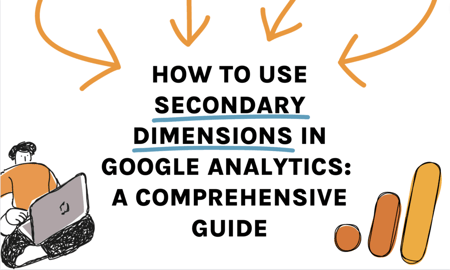Discover Deeper Insights With Secondary Dimensions
Additional measurements work as an effective device in the world of data evaluation, offering a nuanced point of view that surpasses surface-level monitorings. By integrating these dimensions right into your analytical approach, you unlock to a realm of surprise understandings and beneficial connections that can considerably affect your decision-making processes. The capability to divide information from several angles gives a much more comprehensive sight of the underlying factors at play, clarifying details that might otherwise go unnoticed. Keep tuned to discover how second measurements can transform the method you interpret and leverage your information for calculated benefits.
Advantages of Additional Measurements

Among the key benefits of additional dimensions is the capability to boost the context of the primary data. This added context enables experts to attract even more accurate conclusions and make educated choices based upon a much more comprehensive view of the information. Moreover, additional dimensions assist in supplying an extra alternative view of the partnerships between various variables, thus aiding in the identification of underlying elements that might influence the primary dataset.
In essence, secondary measurements play a vital role in enhancing data analysis procedures, providing an extra nuanced point of view that can result in useful insights and actionable referrals.
Execution Tips for Secondary Measurements
Executing secondary measurements properly requires a calculated method that straightens with the particular objectives of the data evaluation process. To start, it is essential to clearly define the goals of the evaluation and recognize the essential metrics that will supply one of the most important insights - secondary dimensions. Select secondary measurements that match the main dimensions and help in uncovering deeper patterns or connections within the data
When implementing second measurements, it is essential to consider the context in which the evaluation will certainly be conducted. Understanding the target market and their details demands will certainly assist the choice of relevant second measurements that add meaningful context to the key data points. Additionally, guarantee that the additional dimensions picked are suitable with the primary measurements and can be effectively compared or incorporated to draw out valuable understandings.
Furthermore, it is recommended to check various combinations of secondary and key dimensions to discover different viewpoints and reveal surprise relationships within the data. On a regular basis improving the selection and assessing of secondary measurements based on the progressing analytical demands will make sure the analysis stays pertinent and insightful.
Analyzing Information With Secondary Measurements

When examining information with additional dimensions, it is essential to take into consideration exactly how different variables connect with each other. By cross-referencing primary data with second dimensions, analysts can discover correlations and dependences that use a more alternative view of the information. This technique not only improves the accuracy of understandings but additionally assists in making more enlightened decisions based upon the findings.
Furthermore, evaluating information with additional measurements enables the identification of outliers or anomalies that may affect the general evaluation. By diving deeper right into the information through secondary dimensions, analysts can gain a more profound understanding of the underlying elements driving the patterns observed in the main dataset.
Taking Full Advantage Of Insights With Second Measurements
To remove a greater degree of deepness and precision from information analysis, leveraging second dimensions is extremely important for making best use of insights. By incorporating additional dimensions into your analysis, you can uncover important partnerships and patterns that might not be quickly apparent when taking a look at data through a key measurement alone. Additional dimensions allow you to cut and dice your data even more, supplying a much more comprehensive understanding of the factors affecting your metrics.
When utilized successfully, secondary dimensions can enhance the context of your main data, offering an extra nuanced point of view on your analysis. By including additional dimensions such as user, geography, or time demographics, you can obtain a deeper understanding of just how different sections engage with your material or items.
Moreover, secondary measurements can help you determine outliers, trends, and relationships that may or else go unnoticed. By exploring your information from multiple angles, you can draw out richer understandings and make more look these up educated choices based on an extensive understanding of the hidden factors at play.
When Utilizing Second Dimensions,## Typical Blunders to Avoid. secondary dimensions.
When integrating second dimensions into information analysis, it is important to be conscious of usual mistakes that can impede the extraction of beneficial understandings. One prevalent error is the abuse of secondary dimensions without a clear goal in mind. It is necessary to specify specific goals and questions before selecting second measurements to ensure they straighten with the evaluation objective.
Another mistake to prevent is overcomplicating the evaluation by including way too many secondary dimensions concurrently. This can bring about details overload and make it testing to attract meaningful verdicts from the information. It is suggested to begin with a couple of appropriate second measurements and slowly integrate a lot more as needed.
Additionally, neglecting data integrity concerns can considerably impact the precision of understandings stemmed from second dimensions. Inaccurate or insufficient information can distort the analysis results and mislead decision-making procedures. Consistently verifying and cleaning up the data is crucial to make certain the dependability of the insights created.
Final Thought
To conclude, the strategic application of additional measurements in information analysis offers an effective tool for opening deeper insights and enhancing decision-making procedures. By integrating extra layers of details, analysts can gain a much more extensive understanding of their dataset, reveal concealed trends, and determine key variables influencing end results. With mindful consideration and execution of secondary measurements, researchers can maximize the worth of their data and drive notified decision-making in numerous fields.
Select second dimensions that match the key dimensions and assist in discovering much deeper great post to read patterns or relationships within the data.
In addition, ensure that the additional measurements chosen are compatible with the key dimensions and can be properly contrasted over here or combined to remove important insights.
Making use of additional measurements in information analysis improves the depth and breadth of insights acquired from the main data factors. By cross-referencing key information with secondary dimensions, analysts can discover relationships and dependencies that use an even more holistic view of the data. By integrating additional measurements right into your evaluation, you can uncover useful partnerships and patterns that may not be right away noticeable when looking at information via a key measurement alone.